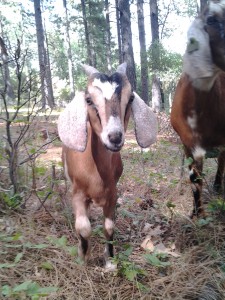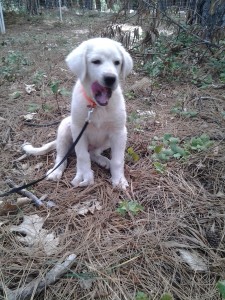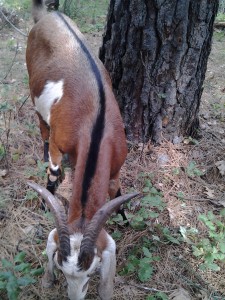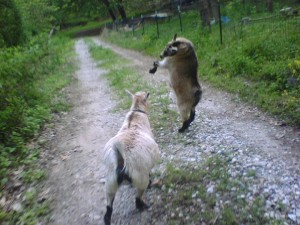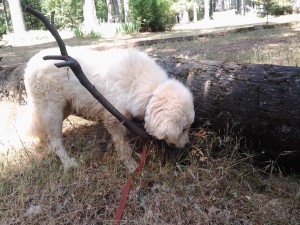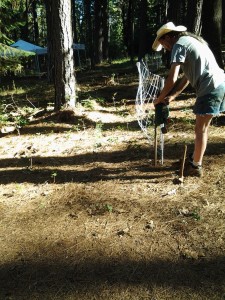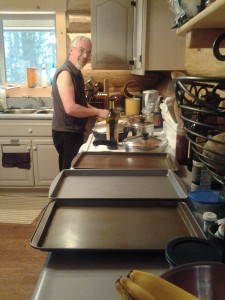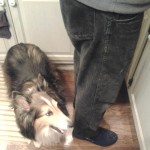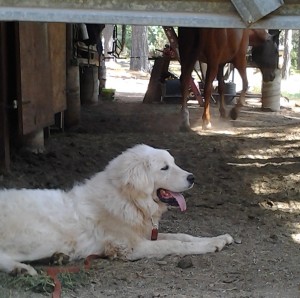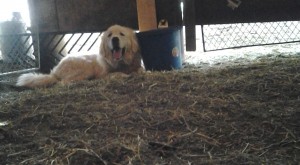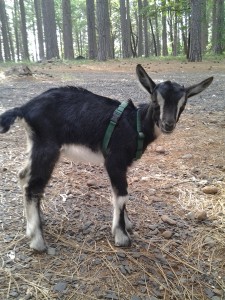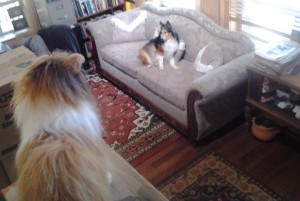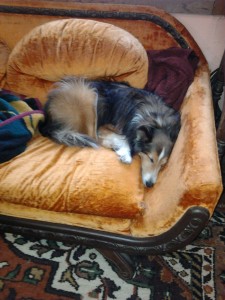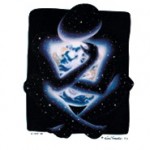And Introducing on Guitar…
Meet the new members of our ragtag little band! Our brush goat herd got three new members this week: Story, a doeling; Dana, an Akbash pup; and Guru, a mature wether to put all these young ones in line! Thanks to our friend Mandy for generously contributing these animals to our project. The poison oak is disappearing as I write.
Story is four months old. She is half Kiko and half Nubian. She has a Disney princess face but don’t let it fool you. She’s ready to use those horns in the service of her independence. She’s curious about me and the bottle baby Ponder, but, like most goats, she likes for things to be her idea. So it goes better when she initiates. She trusts Guru and stays close to him, learning what to eat.
Akbash pup Dana has quite a story herself. She was part of an unexpected litter by one of Mandy’s Livestock Guard Dogs. As she was born with a deformed paw, Mandy was keen to place her well, offering her to us for free as part of various goat deals we discussed. I was resistant because, planning only four goats, I couldn’t imagine we’d need a second dog. But I never forgot this cutie and wished I could help. Mandy finally made us an offer we couldn’t refuse, and Dana came with these two goats. We’ll schedule some corrective surgery soon to declaw one digit where the claw curls under and hurts.
Unlike eight month old Tonka, who is very people oriented and interactive, Dana is a classic LGD, born with the herd, goat and dog focused. She doesn’t like human attention much but we’re working on that.
Dana’s already heavier than our adult Sheltie. And since she’s defiant of walking on a lead as yet, we often have to lug her around when outside the electric pen. Like Story following Guru as a kind of “Mini Me,” Dana scampers behind Tonka, learning her job between naps.
Because her focus has been goats and dogs until now, she’s having the classic LGD upbringing. But because her paw may limit her ability to do the job later in life, and because we have such a small herd and are very hands on with our animals, we want her to be well socialized to humans of all kinds. She might end up as a general farm dog or even a pet.
Consulting The Art of Raising a Puppy by the Monks of New Skete, I appreciate that she’s right in the middle of a critical period in her socialization with humans, especially strangers. We plan to give her opportunities to meet lots of people by taking her with us to the Plaza in Chico, where we go every Saturday for the Food Not Bombs public feeding. I expect her to be shy but it should pay off in the long run.
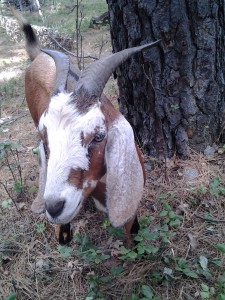
Guru is also a Kiko/Nubian mix. His ears move independently to bat flies, like two marionettes dancing.
Guru is the linchpin of the deal and the herd in general. I wanted a wether (castrated male) of some size and experience to bring Tonka’s exuberance under control and teach younger goats what to eat. Guru is a gravely serious sort, and is filling the niche nicely.
He’s easily twice the size of any of the pygmy goats I used to wrangle. And, being from a brush herd of seventy goats, he’s not used to a lot of human handling, other than for transport, getting shots, or other unpleasantness. So he’s been a handful, along with his apprentice in severity, Story.
We get along great in the pen. He and Story quickly ate pellets out of my hand and let me pet their muzzles, faces, horns, necks, and backs in progression over a day or so. But that first night when we went to corral them to take them to the barn, Guru wasn’t having it. We never did catch him and the entire herd spent the night in the pen. Many herds spend every night in the field, so this was okay, but since we have known predators about, I want them to sleep in the barn.
After taming him with pellets and touch throughout the next day, we were able to put leads on Guru and Story, so we can lead them to and from the barn. When they have bonded with us, they’ll follow off lead. Until then, each trip is a little easier and, even though he would deny it, his cries when I leave the pen let me know he, in fact, enjoys my company!
One more adult wether would complete our little herd. For now, we’re getting to know each other and establish a routine. The goats are eating the brush, including poison oak, which has meant that we humans are starting to get spots from the broken plants. No big deal so far.
Complications? You bet. Tonka didn’t like sharing his barn stall with ol’ big horns so he dug out. Leaving the light on has solved that. I forgot a utility box in the pen, which Story had learned to open with her horns. They helped themselves to grain and scattered other contents around their pen. C.T. pulled a muscle lifting the hefty pup and broke a blood vessel in his hand wrangling Guru by the horns.
Successes? Many! Two large foxes or small coyotes appeared at the pen and quickly trotted away when Tonka got down to business. Everyone respects the electric netting. Even Tonka, who shows no thought of trying to dig under it, as he did in the wire pen and the barn stall. Three of the landlord’s grandchildren came to visit the herd and the animals were curious and gentle.
That visit was a great beginning to socializing Dana, which continues today at the Food Not Bombs feed. Come on down!
—WT
Subscribe to this blog's RSS feed
Building the Herd: A Study in How Complicated Simplicity Can Be
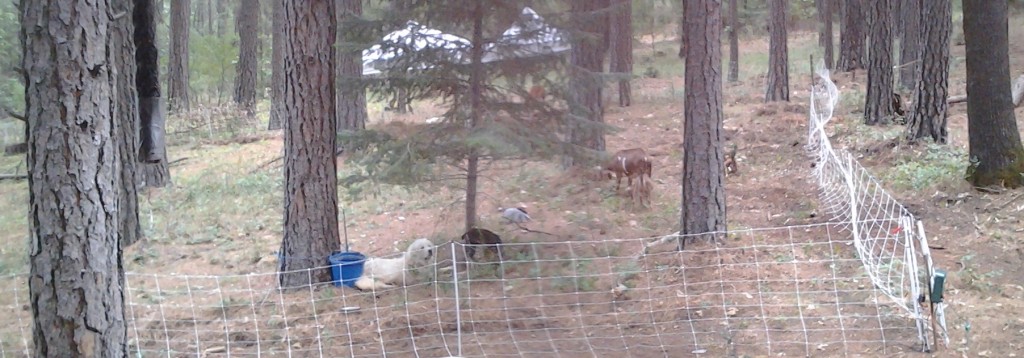 When I started this website and subtitled it “Wren Tuatha’s Complicated Adventures in Simple Living,” I wanted to emphasize the point that simplicity as a value doesn’t mean doing what’s easiest, or even simplest (most expedient) in the moment. Rather, it’s about keeping one’s impacts simplified. That can get very complicated!
When I started this website and subtitled it “Wren Tuatha’s Complicated Adventures in Simple Living,” I wanted to emphasize the point that simplicity as a value doesn’t mean doing what’s easiest, or even simplest (most expedient) in the moment. Rather, it’s about keeping one’s impacts simplified. That can get very complicated!
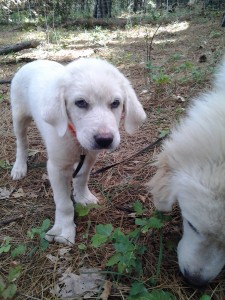 I was just rereading The Art of Raising a Puppy, by the Monks of New Skete. They describe the dynamic in which a dog owner who has lost a mature, elderly dog gets an energetic, untrained puppy. They then judge that pup through the biased filter of their old dog’s obedience and socialization. I could easily have that bias as I build a new herd, remembering how my old goats back in Maryland were so free and easy to be with. We had flow. I forget all the years it took to build up to that state of being. I forget the conflicts with my community mates and fetching the goats out of the garden. I forget work sessions to install fencing and to build a cob goathouse.
I was just rereading The Art of Raising a Puppy, by the Monks of New Skete. They describe the dynamic in which a dog owner who has lost a mature, elderly dog gets an energetic, untrained puppy. They then judge that pup through the biased filter of their old dog’s obedience and socialization. I could easily have that bias as I build a new herd, remembering how my old goats back in Maryland were so free and easy to be with. We had flow. I forget all the years it took to build up to that state of being. I forget the conflicts with my community mates and fetching the goats out of the garden. I forget work sessions to install fencing and to build a cob goathouse.
I just remember the easy routine the goats created. Wicca and Niabi were up at sunrise, following their daily path to their preferred morning browsing grounds. When I got up they would make their way back to my cabin to talk to me through the windows. After a long day of circling the woods to find the best browsing in relation to the sun and my comings and goings, they would settle in under the house, preferring to sleep there, close to me, completely forgoing the beautiful cob house we built them in their secure pen.
For the last few years that I had goats in Maryland, their gate was almost always open and their pen was just another part of the woods to be eaten. They had evolved that level of freedom with me through trust, bonding, and experimentation.
But Maryland has surprisingly few mountain lions. The equation of having woodland goats in California is very different. And this herd will be different, in mission and relationship to me.
Before, I had pygmy goats as pets. I committed to them the way I would a dog or cat—for life. That included health care, the highest quality food and entertainment I could afford, and lots of loving. I don’t know what the future has in store for me and these animals. I’m sharing them with my landlords. Many things are different.
Simplicity Concept: Let’s get pet goats to clear brush instead of using chemicals or human hours!
Complication 1: Seriously Apex Predators
Lions, coyotes, and bears! Oh my! In this part of the country, if you have a herd or flock of any kind, even chickens, you either have Livestock Guard Dogs or you have losses. We will spend more on dogs than fencing. Since we are only going to have four goats, I have insisted we only need one dog, Tonka.
He’s an eight month-old Akbash/Anatolian/Great Pyrenees mix. But another herd owner wore me down and talked me into adopting Dana, a ten week-old Akbash pup with a deformed paw. Mandy, who has seventy goats, wanted me to have the pup as, the dogs work best in teams. Although my reading suggests LGD’s take two years to mature into the job, Tonka’s doing an amazing job already. He chased a pair of coyotes off just yesterday. He also alerted us when the bottle baby got stuck in a hole. Dogs are a great addition!
Complication 2: Please Fence Me In!
With mountain lions about, evolving goats into being free range is not realistic. Since we want them to clear brush all around the landlord’s forty acres, we’ll need movable fencing. Technology has marched along and the trend now is
electric netting. The shock is quicker and milder than old style fences and the sections are lightweight and easy to move and install. The power can be household current, battery or solar. In the old days I would have thought this inhumane. I remember the jolts the electric fences on our farm would deliver. But each herd member only has to contact the netting a couple of times and they respect the fence forever. The netting also provides some deterrent to predators.
Complication 3: LGD’s Don’t Know Sit
Livestock Guard Dogs are bread to know their job innately and learn what they don’t know from elders on the job. They’re born with the herd and they bond with goats and other dogs, not so much with humans. Their human handler needs to take alpha rank over the dogs but, like many show dogs, basic obedience is not needed or taught. So when we brought Tonka home, he was used to a leash but didn’t heal, sit, stay or down. Sorry, but if I’m going to handle a herd that includes a dog that could approach a hundred-fifty or two hundred pounds, I need him to sit on command.
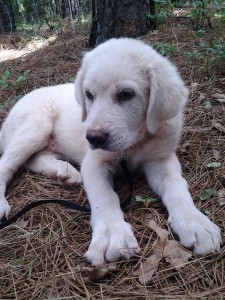
Dana drags a leash to aclimate to it. She'll get surgery soon to improve her deformed right front paw.
Although Tonka is unusual in that he’s submissive and people friendly, the pup Dana wants little to do with humans. According to the Monks of New Skete, I’ve got just three weeks or so to socialize her to a variety of humans, otherwise she will have a very hard life if her deformed paw limits her LGD career. So now I’m a dog trainer.
Complication 4: Some Goats Are Gruff
I previously kept pygmy goats, a dwarf breed. My heaviest goat was maybe seventy pounds. I usually got them upon weaning and was very hand-on. Others I got from pet herds. That’s common with pygmies, which are kept more by fanciers than farmers. So I was used to very tame goats. When I got Ponder, the bottle baby, I knew she would grow to one hundred-thirty pounds. But I’m her mama. She’s tame. But the adult wether and young doeling Mandy gave us came from a herd of seventy brush goats. They’re used to seeing humans, but human touch equals unpleasantness—shots, transportation, and this time, rehoming. 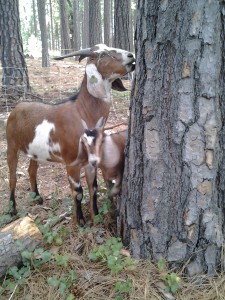 So I have a goat twice the size that I’m used to, he has a huge rack of horns, and he’s not interested in being my friend. Never underestimate the power of feed pellets. You will be mine, Guru!
So I have a goat twice the size that I’m used to, he has a huge rack of horns, and he’s not interested in being my friend. Never underestimate the power of feed pellets. You will be mine, Guru!
Complication 5: Surprise! This Stuff Costs Money!
I’m perfectly clear that I’m starting this herd for enjoyment of their company as well as brush clearing. Otherwise, if brush clearing were the sole benefit, I’m not sure the finances, effort, and time would make good math. Then again, I’ve met several folks who run brush herds for money, so they must make it work on a certain scale. Luckily the landlord and I each have a few collars, halters, leashes, bowls, toys, etc., left over from previous animals. We’re trying to make due with odds and ends we find in these tough economic times. We won’t eat or milk these goats, nor get any fiber from them. So brush clearing and entertainment are our only benefits. But goats and dogs need shots and sometimes have accidents, creating emergency vet bills. Add in puppy food for two and supplemental grains and hay for the goats. Thanks to another goat person, Jen, we’re getting goat milk for the bottle baby. That’s a generous gift, and great savings. The horse barn was already here and the landlord used recycled materials to adapt it to goats. I am repurposing my two EZUp canopies to create shelter in the movable pen.
Simplicity Is Responsibility, not Ease
Live simply so others can simply live. I notice people often falling into a couple of traps in their understanding of Simplicity. One is thinking that it’s about benefits to the individual. I’ve seen it packaged that way, and certainly Americans understand things in individualist terms. People want simplicity to mean more time with their kids, more time for hobbies, less time working an unsatisfying job, fewer possessions by which to be owned. It can be all these things, but this is the shallow end of the pool, and it doesn’t account for simplicity’s complications, as I sketched out above. But going deeper, simplicity is about taking no more than your share of resources, so others can access their shares. Live simply so others can simply live. Modulate your privilege.
The other trap I’m thinking of is the idea that money is the root of all evil and that simplicity must mean a life without money, to the greatest extent possible. I’m not sure, but I’m told that the actual quote is, “the love of money is the root of all evil.” That certainly changes things for me. I see money, like time, labor, etc., as a form of energy. Any energy can be expended for good or bad by anyone. I’ve often said that money can’t buy you love, but it buys you choices. And in a thoughtful simplicity practice, you can choose to spend money to ethically benefit people in your local region and around the world who are trying to simply live.
Simplicity isn’t about you.
—WT
C.T.’s Cooking Again!
C.T. is one of those folks who just loves to feed people. This has worked in our relationship because I don’t care if I never cook again, but I do love to eat great food.
As we’ve moved a lot, C.T.’s happiness has been somewhat measured by the relative cooking-friendliness of the available kitchen. For example, he was very challenged by my hotplates and toaster oven in Hina Hanta, my cabin at Heathcote. So when we moved into Serenity, our RV, he was thrilled to be “cookin’ with gas” on a four burner propane stove. He actually loved the galley in the RV.
Most recently, he had been living in a group house in San Francisco, working at a job there to prepare the way for our move. For four months he had a nice kitchen but did very little real cooking because his housemates didn’t share meals. With me back in Maryland, he had no one to nurture with cooking.
Now we’re under the same roof again and have a great kitchen for his projects. We’re also going to lots of potlucks and other functions where C.T. gets asked to provide food. Add in our recent housewarming party, and C.T.’s having a blast!
There are some dishes in regular rotation, and some experiments. Old favorites include C.T.’s Guatemalan refried beans, the always satisfying cream of broccoli soup from our Heathcote days (it’s vegan, with a cashew/potato base), white bean and chard lasagna, eggplant parmesan, and garlic kale.
C.T. has also taken over cooking batches of our homemade pet food, and he serves our dog and cat their meals. So they pay attention to his every movement in the kitchen. As a matter of fact, they get under foot quite a lot, micromanaging him. I think he enjoys every moment of it!
Will we find ourselves in Community again? Food was a great community builder in our lives at Heathcote. We shared food and cooking responsibilities, but also the rhythms of life, as we came together to share stories of our days and continue ongoing dialogs.
For now, C.T.’s cooking for our little household. He might hook up with other opportunities to feed people. Folks in town are organizing a pay-as-you-can cafe. And C.T.’s gearing up to organize local Food Not Bombs activists to create a food redistribution network. I can imagine some of that food will find its way into C.T.’s bulk pots.
As we learn what’s fresh and local in our new bioregion, meetings, emails and discussions continue. Guacamole, anyone?
My Decoy Collection
 Smiles. The satisfied curves and earthy colors feel warm and cute. The lines and an unexpected woodgrain draw the mind into another time, before gridlock and the internet, a time one imagines to be simpler.
Smiles. The satisfied curves and earthy colors feel warm and cute. The lines and an unexpected woodgrain draw the mind into another time, before gridlock and the internet, a time one imagines to be simpler.
One of the joys of finally landing in our California cabin is that I have unpacked my humble collections, after three years of not having a home of our own. My folk art decoy duck collection is now scattered around the surfaces of my living space. They’re helping to bring a feel of home. place, and normalcy three years after I lost the home I’d had for nearly two decades.
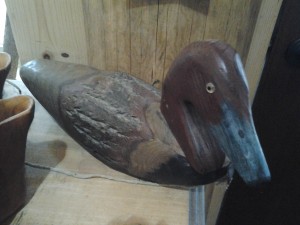 I supported myself during film school by doing eco-friendly housecleaning and organizing. On the organizing side, ninety percent of my consultation had to do with getting people to get rid of stuff, not just rearrange it. I liked the advice from several organizing books to put items in trash bags and put them in the attic, basement or closet for three months. Anything that you don’t go to the bags to get in that time is something you don’t need. Then the client or I would take the bags, unopened, to a local thrift store or charity. Of course, these trash bags were usually filled with eight of the client’s yellow sweaters, reams of old musty copier paper, surplus toys for the grandchildren that live across the country, etc. They didn’t tend to include the favorite artwork.
I supported myself during film school by doing eco-friendly housecleaning and organizing. On the organizing side, ninety percent of my consultation had to do with getting people to get rid of stuff, not just rearrange it. I liked the advice from several organizing books to put items in trash bags and put them in the attic, basement or closet for three months. Anything that you don’t go to the bags to get in that time is something you don’t need. Then the client or I would take the bags, unopened, to a local thrift store or charity. Of course, these trash bags were usually filled with eight of the client’s yellow sweaters, reams of old musty copier paper, surplus toys for the grandchildren that live across the country, etc. They didn’t tend to include the favorite artwork.
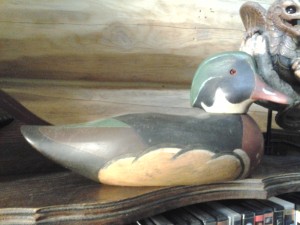 Even so, collections can seem counter to the lifestyle of simplicity. Collections can start to own the owner, like cars, large houses or possessions in general. So what is my relationship to my decoys now?
Even so, collections can seem counter to the lifestyle of simplicity. Collections can start to own the owner, like cars, large houses or possessions in general. So what is my relationship to my decoys now?
For three years my partner C.T. and I lived in an RV while our files, kitchenware, and assorted collections were in storage. I brought one carved decoy with me onboard. It promptly fell off a counter on the first day of travel, its neck broken. While we lived in a succession of friends’ driveways, teaching consensus workshops to Occupy encampments and scratching out a living, we were not surrounded by our stuff. It was freeing. We didn’t miss most things. 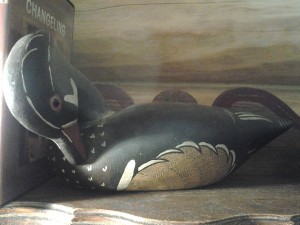 Rarely did we visit our storage to retrieve things. So if we’d followed the advice from all those organizing books, we would have given away our possessions and moved to our California cabin with only what we had in the RV.
Rarely did we visit our storage to retrieve things. So if we’d followed the advice from all those organizing books, we would have given away our possessions and moved to our California cabin with only what we had in the RV.
Here’s what I noticed in those three years that the three month trash bag test doesn’t address: Although I didn’t miss the objects in storage, I missed something very core for me that they collectively represent: Home. I missed my sense of place, of belonging to a place. I come from landed, rooted people and I’ve always framed my sense of safety and security around my sense of place.
 So there was no question that we would bring my decoys and my gemstones and my Blenko glass to California and position them lovingly on my sideboards and buffets. When C.T. and I wired in our stained glass lamp above the dining room table, a beacon shining all the way from our old cabin in the woods of Maryland to our new log home among the Ponderosa pines, some part of each of us exhaled. We are going to be okay.
So there was no question that we would bring my decoys and my gemstones and my Blenko glass to California and position them lovingly on my sideboards and buffets. When C.T. and I wired in our stained glass lamp above the dining room table, a beacon shining all the way from our old cabin in the woods of Maryland to our new log home among the Ponderosa pines, some part of each of us exhaled. We are going to be okay.
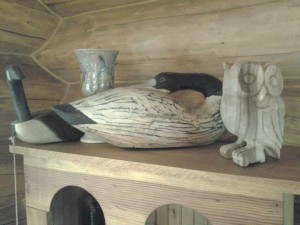 How did I start with decoy ducks? What is their meaning, past and present? I was a very young Sunday School teacher. My director, a mentor and second mother to me, called us together for a teacher training. We were to sample a curriculum that explored totem animals. Yes, it was a Unitarian-Universalist program, so totem animals. We were supposed to bring an item from home. Of course, ADHD me, I forgot mine. But what I had intended to bring was Fredrica, a mass-produced wooden decoy duck I’d picked up somewhere.
How did I start with decoy ducks? What is their meaning, past and present? I was a very young Sunday School teacher. My director, a mentor and second mother to me, called us together for a teacher training. We were to sample a curriculum that explored totem animals. Yes, it was a Unitarian-Universalist program, so totem animals. We were supposed to bring an item from home. Of course, ADHD me, I forgot mine. But what I had intended to bring was Fredrica, a mass-produced wooden decoy duck I’d picked up somewhere.
Why was I drawn to this object? At the time, I joked that I thought of myself as a “sitting duck” for conflict and controversy, like the working decoys that  are used for hunting. I probably, even then, made some reference to the lines and curves, the rustic mood of the wood, the primitive style of the paint. Later, as I opened up to Paganism, I would appreciate that ducks are creatures equally comfortable in the air, water and on the ground. Leave the element of fire out of the equation; I’m vegetarian!
are used for hunting. I probably, even then, made some reference to the lines and curves, the rustic mood of the wood, the primitive style of the paint. Later, as I opened up to Paganism, I would appreciate that ducks are creatures equally comfortable in the air, water and on the ground. Leave the element of fire out of the equation; I’m vegetarian!
I started to collect little mass produced ducks and eventually started replacing those with serious signed art pieces by known carvers. Although my collection is humble by most collectors’ standards, I feel complete. For a while, friends and relatives would gift me ducks at every gift occasion. I had duck note paper and duck soap dishes. Most of those are long gone if favor of the art pieces I’ve managed to collect and I’ve trained folks out of giving me, well, anything.
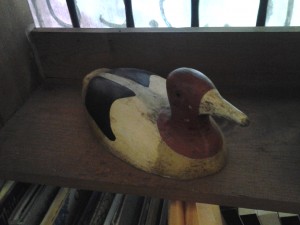 While people were gifting me ducks they started to threaten to buy me live ducks. Eventually one Easter I beat them to it by getting six Pekin ducklings at a feed store. I raised them in my classroom at the University of Louisville Child Care Center before moving them into my back yard. This began several years of living with live ducks. I came to favor black Indian runner ducks, with their wine bottle shaped bodies, scampering gait, and amazing iridescent peacock colored feathers.
While people were gifting me ducks they started to threaten to buy me live ducks. Eventually one Easter I beat them to it by getting six Pekin ducklings at a feed store. I raised them in my classroom at the University of Louisville Child Care Center before moving them into my back yard. This began several years of living with live ducks. I came to favor black Indian runner ducks, with their wine bottle shaped bodies, scampering gait, and amazing iridescent peacock colored feathers.
When I moved from my downtown Louisville home to Heathcote Community in the woods of Maryland, I moved my dog, ducks and goats to what I thought would be an idyllic life for all of us. But over a couple of years I lost my ducks to predation, mostly weasels. It was just too hard to give ducks freedom and safety in the woods.
 So now I live in the woods with dogs, goats and C.T., sitting in our log cabin among my folk art decoy ducks, creatures of the buffet, shelf, and the stereo speaker. They’re wood, lovingly carved into the round, comfortable shapes of creatures that make themselves at home even as they migrate, even as their place in the food chain makes home, family and life itself into gifts so easily taken away.
So now I live in the woods with dogs, goats and C.T., sitting in our log cabin among my folk art decoy ducks, creatures of the buffet, shelf, and the stereo speaker. They’re wood, lovingly carved into the round, comfortable shapes of creatures that make themselves at home even as they migrate, even as their place in the food chain makes home, family and life itself into gifts so easily taken away.
My decoys remind me that the security that defines sense of place is not absolute security, or even really true in the moment. It’s the familiarity of knowing one’s surroundings and letting the guard down. It’s building a nest even though it may be destroyed. It’s getting comfortable during the impermanence of life. Some would say it’s the point of life.
To the Woman Who Jumped out of the Vehicle in Front of Mine on Skyway
Did you know what would happen? Did you jump toward something or away from something? Was it the alcohol or some alter personality that made the final split-second decision? As your body rag dolled out of his moving pickup, did you feel your impact with the road? Was that a more tolerable option to something else, or was your mind in another world?
Because your body was very much here. On the side of the road. A woman’s body, limp, like the tarp that wriggles loose on moving day, landing on the ground with no agency to leave its resting place on its own. Who discarded you?
The story of your day was revealed in pieces as I talked with bystanders and listened to police and paramedics investigate. You had been drinking all morning. You take lots of meds. No meth or pot. You had been arguing with your day care provider so the driver of the pickup was taking you to his house to sleep off your drunk and cool down. You demanded alcohol from him as the two of you rolled down Skyway, where I pulled in behind you. When he refused to give you a drink, you decided to leave the vehicle, not waiting for him to finish slowing down and pulling over.
That’s the story of a moment, but that’s not the story. Chronologically speaking, you were probably once somebody’s baby. But that’s a lullaby when a life needs an opera. There’s no one to write your opera, filled with childhood friends, jobs, favorite dishes, incremental hurts. But what about all these silent, unrecorded moments of abruptness? An elephant steps on an ant, someone gets fired and goes home. Someday our sun will die. The vast silence doesn’t mark things. People do, when we become aware. We note the time, we sort and classify.
I have no category for your unconscious body on the asphalt. I’m deciding to leave it that way, as the only way I have for honoring the story I don’t know. I notice my very human hope that you will heal, that your story will continue. But that’s my need for a box with a lovely ribbon. No one can honestly offer a different world to you. I don’t know what is best.
We’re Well Protected Now, If Slobbering Is a Deterrent
 Meet Tonka. He’s big. He’s the latest member of a brush goat project we have with our landlords.
Meet Tonka. He’s big. He’s the latest member of a brush goat project we have with our landlords.
Back east, I had goats for about twenty-five years. Predators were never a huge issue. But here in Northern California, goat owners have to contend with coyotes, bobcats, bears, and, yes, mountain lions. Folks seem to address the issue by blending various Livestock Guard Dog breeds of the world. That’s what we have in Tonka, a blend of Akbash, Anatolian and Great Pyrenees.

With Tonka to protect her, Ponder has moved from the house to the barn, awaiting the arrival of other goats. With him, she's freer to explore her world.
Mostly using their sheer size and threatening postures, LGD’s have cut the predation rate by 90%, including against mountain lions.
LGD’s aren’t herding dogs in the sense of moving the herd around. They’re not general farm dogs and they’re definitely not pets. In our shopping for goats and an LGD we met some dogs that were fierce and menacing protectors of their herds. Since we will top out at about four goats, we opted for the teddy bear model.
Tonka, named for the line of toys featuring large, lumbering farm equipment, is seven months old. He’s around a hundred pounds and his hip is as tall as mine. He also loves plush toys, giving drooly kisses and showing his belly. He remembers bottles and wants the baby goat’s bottle badly. Even so, if a mountain lion showed up today, I know he’d put on a great show.
I know this because his bond with his little charge was instantaneous. In the car on the way home from getting him, I told him all about his baby goat. I told him his job was to protect her. Since he’d lived with a herd of boer goats since birth, I imagined he knew some of my words.
When we brought Ponder, the three week old doeling to him, he wiggled for joy, proceeding to lick and gum her from stem to stern. She was less thrilled at this bonding ritual, but has grown to trust him completely in two short days.
Who will join us next? We’re making great connections among various goat people. I hope to find two or three mature wethers and/or does to harvest this bumper crop of poison oak we have here. Stay tuned!
How Adding a Baby Goat and a Housewarming Party to a Full Schedule Makes Me More Efficient
I once read an article by a writer who was a stay at home dad for a young child. The article was about how having the constant care of his child actually made hime a better writer by forcing him to focus, down and dirty, and stop indulging all the white space of his writing process.
So, that. I knew I wanted to create balance in my life now that we have a home and are staying in one place to do our consensus work. My usual work pattern was feast or famine, to throw myself into a relentless 24/7 of thinking about work, doing work, traveling to work, phoning about work, and on. I don’t toss out eating, but goodbye to working my locks, sex, friends and fun.
Add to the mix that I struggle with fatigue. I have my good days and bad days. But I push through. So work.
Soon after arriving in Chico, California, our networking bore fruit and suddenly we’re in the whirlwind of meetings, phone calls, pamphlet writing, workshop scheduling and chronic exhaustion, all without an income.
So, it seems like this is not the best time to add an optional event, our housewarming party, or an optional family member, like a baby goat. But balance. And just like that writer dad with a child to prioritize, I find myself, within the limits of my energy, organizing myself and getting to the nitty gritty of what needs doing. And I’m happier because, well, goat and party!
Introducing: Ponder
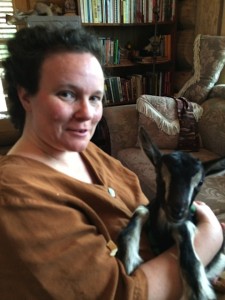 No complicated adventure in simple living is complete without a baby goat. Them’s the rules. So allow me to introduce Ponderosa Impala, Ponder for short!
No complicated adventure in simple living is complete without a baby goat. Them’s the rules. So allow me to introduce Ponderosa Impala, Ponder for short!
I had no idea that we would add goats back into our lives any time soon. As renters, and without a firm plan for our cash-flow, we had back-burnered getting new goats. Besides, our grief from losing our pygmies Wicca and Niabi is still fresh.
We had told our landlords about our life with goats. They actually had been thinking of getting some for brush clearing around their property (their house and ours) especially because of the bumper crop of poison oak. C.T. and I were excited about brush goats as a solution to the poison oak. As soon as we moved in, our dog Tuatha carried the oils into the cabin and Papa C.T. erupted into an impressive rash on both arms. As the less allergic partner, I wasn’t looking forward to pulling up the thousands of poison oak plants that continue to creep toward our walls. Besides getting rid of that threat, we just enjoy life with goats.
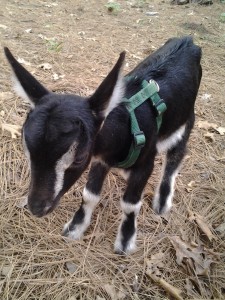 After a few conversations with our landlords about the cost and responsibility of goats we decided to share a micro herd of three or four dairy goats. Because we are in country with large predators—coyotes, bears, mountain lions, etc., we agreed the herd would include a trained Livestock Guard Dog. If the first herd member is any indication, much blogging will follow!
After a few conversations with our landlords about the cost and responsibility of goats we decided to share a micro herd of three or four dairy goats. Because we are in country with large predators—coyotes, bears, mountain lions, etc., we agreed the herd would include a trained Livestock Guard Dog. If the first herd member is any indication, much blogging will follow!
Ponder is a two week old doe from a large scale dairy on the other side of Chico. She was in a pen with about thirty other newborns, Like all the others she was taken from her mother at birth and bottle-fed. All the does were crowded in the barn. I don’t know how much outside time they get. Ponder’s life will be different. I’ll continue
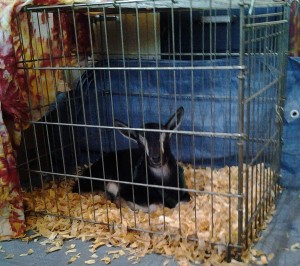
While she waits to move to the barn, we are her herd. She has a crate in the house and a movable playpen in the yard.
her bottle feedings for another six weeks. I’ve known about bottle babies for a long time but I never made the commitment until now. Although I think she should get all of her mother’s milk, I’m enjoying this unique relationship and I’m glad that this discarded goat is on the track for long and happy life.
Ponder is a perfect baby. She transitioned from her barn to the car with minimal drama. The dairy’s Livestock Guard Dog tried to eat Tuatha. But other than that, smooth. Very little crying compared to my first goat, Tabitha, nearly twenty-five years ago or so. But Tabby was older. I adopted her at weaning. Being so young, Ponder has bonded with me and C.T. and Tuatha very quickly, following us around like a little long legged shadow. Leeloo, our cat, is another story. With the baby goat being just barely taller than her, Leeloo feels pretty threatened. Plus, all of a sudden she’s the middle child. ‘Nuff said.
At two weeks old, Ponder is already nibbling plants she encounters, getting ready for her job as a brush goat. While Ponder eats, grows, and waits for her herd to arrive, I’ll continue to research temporary fencing and plan adaptations to our landlords’ horse barn. We have an appointment to visit with a friend of a friend who does brush goats for a living. She has LGD pups trained and ready for new homes. We’ll see!
Who will join her? We’ll probably get wethers, castrated males. Ouch, I know. It sounds cruel. But it actually gives male goats not desirable for breeding a chance at life. Unaltered bucks have a strong odor, are often aggressive and urinate on themselves. Intentionally. Most humans find them hard to live with and with only about one in a thousand bucks being saved for breeding, weathering removes all these unwelcome traits and saves many from slaughter by making them very friendly, affectionate goats. They make great pets, companion animals for solitary horses, etc., and brush goats! Over the decades that I had pygmy goats, half were does and half were wethers.
I was attracted to pygmies for their dwarf size. Patti, my partner at the time I started, insisted I could not have a pet I couldn’t carry by myself, in case of emergency. That’s always made good sense to me and I have stuck to it. but little Ponder is an Alpine dairy goat. She’ll grow to about one hundred thirty pounds. Larger goats will be a new experience for me!
“The Woman Always Gets to Say No!”
 Damn right, my Craigslist vampire. I posted an ad seeking a job, not seeking to augment your hand job.
Damn right, my Craigslist vampire. I posted an ad seeking a job, not seeking to augment your hand job.
[I'm distracted in the moment by the fact that some webpage review site flagged Hippie Chick Diaries as inappropriate for children because of the phrase "Japanese fantail pussywillows." But I bet they miss the above retort altogether...]
Let me find a beginning to this story and roll it out.
Our fresh start in Calfornia requires that I find work. Besides searching posts of job offerings, I posted my own ad, describing what kind of work I seek and my background. I posted it under resumes. In the ad I clearly state that replies can be by phone or email, NO TEXTING. I hate texting. And like an employer, I judge respondents on whether they can follow these directions. Of course I get a few automated spam texts.
But after two days the only phone response I’ve gotten was from a man I’ll call Jake. I could try to make the pseudonym more meaningful, but I don’t think my writer’s collection of baby name books will provide me with a name that means “self-absorbed to the point of being incapable of recognizing the autonomy and personhood of women.”
It’s a story of my desperation to create cash-flow for myself colliding with his skill in plausible deniability. That’s why I gave him any time at all. He asked about my ad. He said he was “in the law,” and needed an assistant. He didn’t sound businesslike, but he stayed enough in the content of my posting that I kept giving him a few more seconds, another minute, to make sure that he was not a possible employer who tragically lacked phone skills.
When he revealed that he was in New York City (his Manhattan area code told me as much), that he would be in my area soon, that he wanted to meet me and send me his picture, I cut him off. Regretfully, I’m being metaphorical.
I informed him outright that I had no interest in receiving his picture and that I placed the ad looking for employment in my field, nothing else. “Just in case, can’t I send my picture? You never know…” Oh, believe me, I know. We’re done, and I’m being nice here.
“The woman always gets to say no. You know it’s true. The woman always gets to say no.” I hung up, knowing he would not hear anything other than what he wanted to hear.
But for the other Jakes out there, who just want to be loved and who are not triggered at the moment, let’s look at why women always say no to you. First, Jake answered a resume ad with his veiled request for sex/companionship. Dude, you’re using power (offering a job, honestly or not) to get sex. You deserve a take down. Secondly, and I want Jakes and all readers to appreciate this on a structural level: Here’s how questions work. You have one person who is an asker and another person is the answerer. The asker asks the question. That’s why that person is called the asker. The other person, the target/object/receiver/victim of the question, is the answerer. It’s definitional. The asker of a question is the asker. That person doesn’t get to say yes or no. The asnwerer of the question gets to respond with yes or no. This is how asking questions works. It’s the physics of questions.
So Jake, if you call me on the phone and you ask me a question, like, “Can I send you my picture?” You called me. You are the asker. I get to do the answering part. You don’t get to do both. You’re allowed to have whatever feelings are authentic for you regarding my answer. But you don’t get to blame me for being the answerer when you started the interaction by being an asker.
Jake might be wondering why he’s always the asker, never an answerer. Always a bridesmaid, right? Well Jake, you might want to check your self absorption, which led you to call a job seeker with a sexual request. (You can walk into a Mexican restaurant and order Chinese, but don’t expect to succeed in your goal.) Check your male privilege that has you, yet again, attempting to use power, such as pretending to offer a job, to get a woman to talk to you much longer than I imagine most women do, face to face.
Want to be loved? Be lovable. Be lovable by being safe. Want to be asked? Be safe by learning to modulate your male privilege and honor social boundaries. And while you’re trying to figure out what the hell I’m talking about, yes, Jake, the woman always gets to say no. It’s structural, the way a table is not a chair, even if you decide to sit on it. Why, then, blame others when it’s not comfortable, or someone asks you to move?
—Wren Tuatha
Please join our Hippie Chick Diaries fan page on Facebook!
A Couch Makes a Home
To me a couch, like a car, is a very important data point of self expression. A couch mirrors the style, even the personality of its owner/rider. It’s a sanctuary, a love nest, a theater seat, infirmary cot, magic carpet, and of course, pet magnet.
My couch has always been an anchor, whatever house I lived in. Like cars, I’ve gone through many, and am usually the final owner. When I sold my house in Louisville to move to Heathcote and sold my tapestry-fabriced two-recliner “couch potato” couch to my old roommate Jane, it was kind of a big deal. Just to remember the ultimate couch, I kept two if its cushions! Still have ‘em.
Like friends of mine who live in their cars or out of suitcases, I went couchless for several years while I resided in the tiny springhouse at Heathcote Community. Inside my little stone hut my bed doubled as my couch. And there were couches to be ridden in Heathcote’s common house, the mill. So I didn’t lack the comfort of couches.
When I moved into a larger space at Heathcote, I took an old school bus seat out of the barn to be my couch. The novelty of the school bus seat didn’t make up for its lack of comfort, nor the fact that it was heavy and dangerous when it tipped over, which it did often. It was not a sanctuary of any kind.
So I eventually got a thrift store couch, the colors of which matched my green rug beautifully for years until C.T. pointed out that the springs of the back were giving up. Comfort gone, purpose gone. Next!
Someone leaving Heathcote gifted me an interesting Duncan Pyle couch, extra long and low with carved wood accents and uncompromisingly orange fabric. I would have hauled that couch to California with me, but it spent a very unkind year in storage and had a smell.
So I ventured on, couchless, and the universe kept providing me with stand ins—first a plaid couch and love seat set at the ranch house in Temple Hills, Maryland where I lived for nearly a year and then, yes, the landlord of our log cabin here in Magalia agreed to leave a vinyl couch in place for us. A house is not a home without a couch.
Yet, vinyl, ick. Great stand in but my eyes would always scan the thrift and antique stores up and down Skyway, the main drag here on the ridge. Sure enough, I saw something special and C.T. and I turned around. Carved wood trim, more padded and cozy than the Duncan Pyle, it needs reupholstering, but Honey, don’t we all? The owner let us have it for $50 and he delivered it to our cabin a couple of days later. He even took the vinyl couch away, which, it turns out, the landlord had bought from this same dealer before. Couch recycling.
On the list of things we need to replace or buy in our move, the couch was a low priority. But this was a great find at a great price. And as we continue to unpack, arrange our things and hang pictures, and watch movies from our new old couch, this cabin in the woods is really starting to feel like a home!
